This second issue of Diario Romagna moves on two distinct time planes, but united by the same intent. You will find the voices of the volunteers who immediately rushed to help the Guerrino Tramonti Museum (among the museums at the center of the first issue’s reconnaissance). Following in time, but going geographically up the space of the hills overlooking Faenza, we arrive in Modigliana where this weekend (July 27, 29, 30 and August 1) Terra Mossa will be held, a festival that focuses on participation, a way to highlight the different souls of volunteers: from experts in restoration to the sounds of a concert in the hills, all witnessing the same conviction: creativity and art are the only answer.
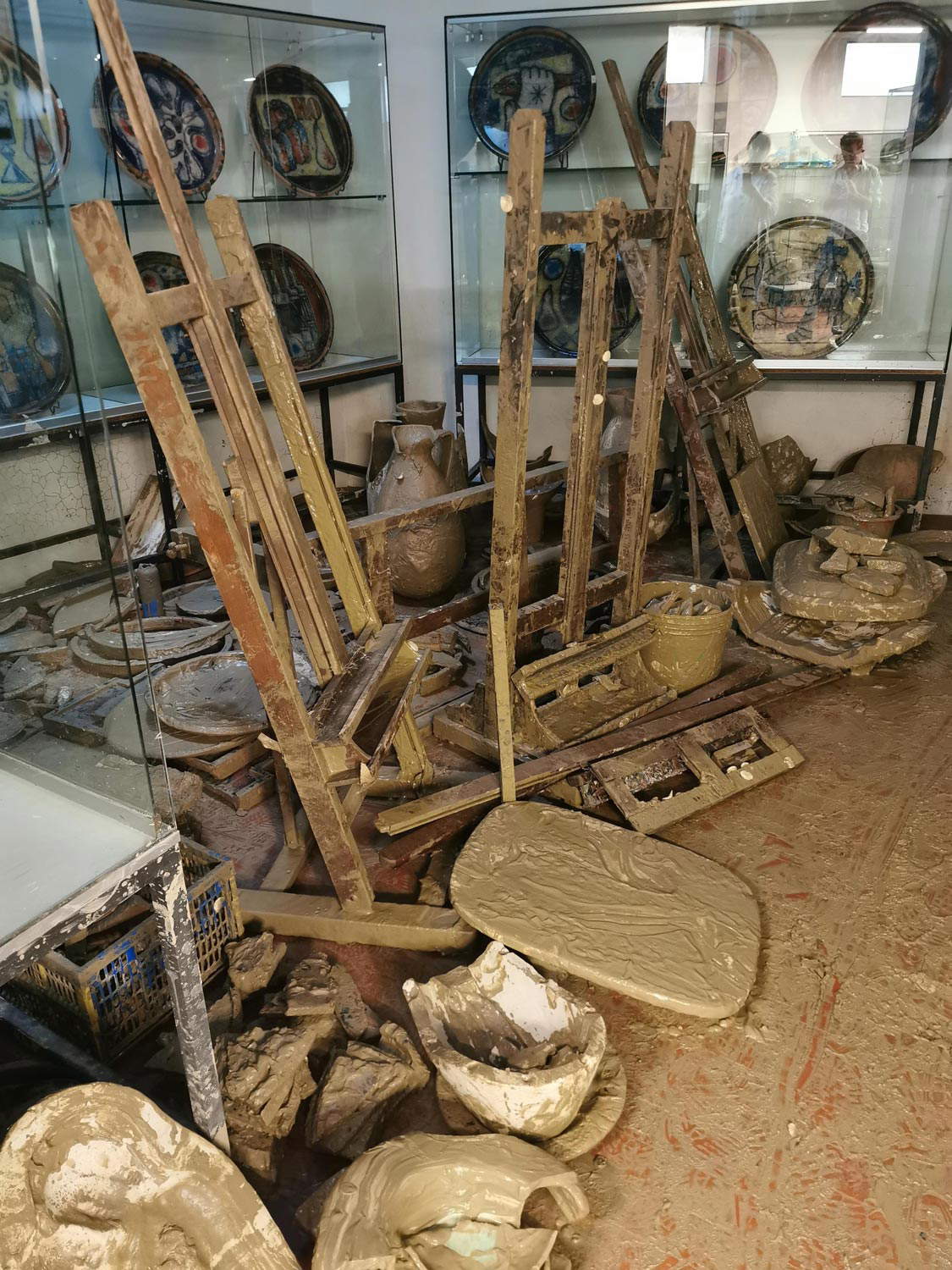
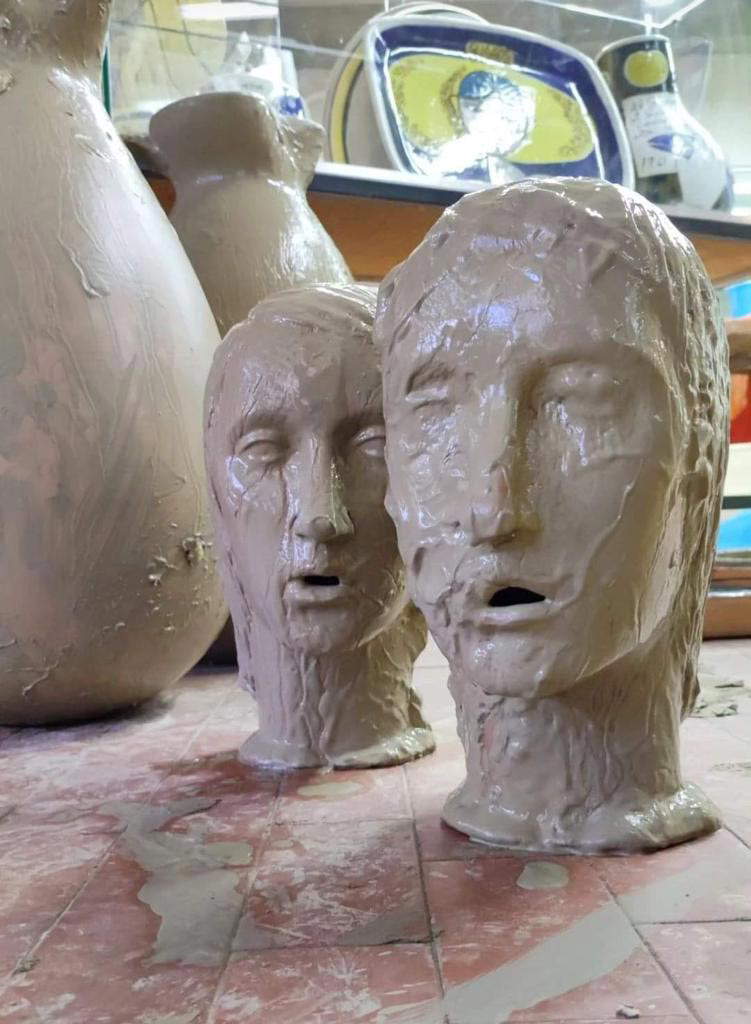 Guerrino Tramonti Museum
Guerrino Tramonti Museum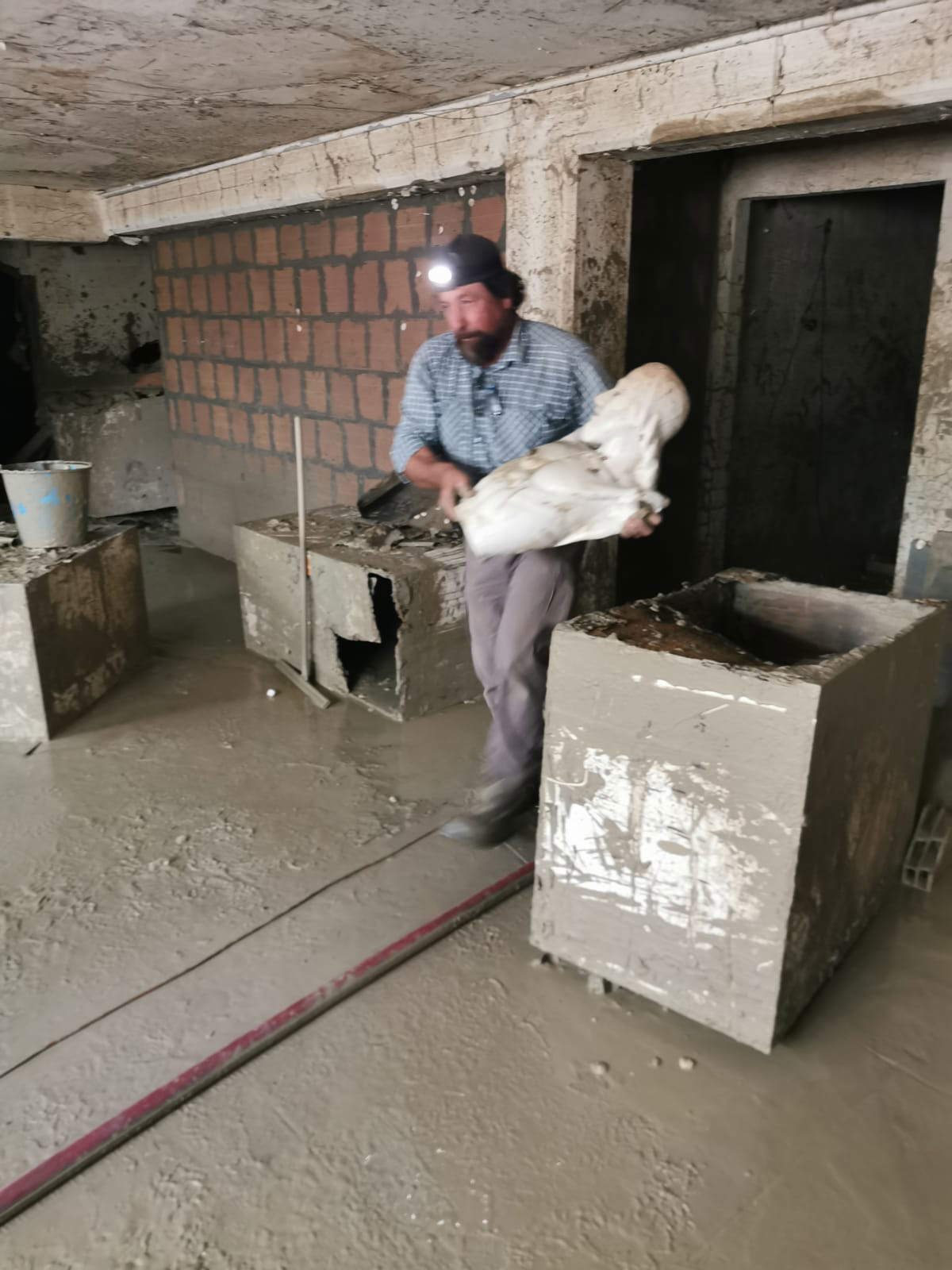 Guerrino Tramonti Museum
Guerrino Tramonti Museum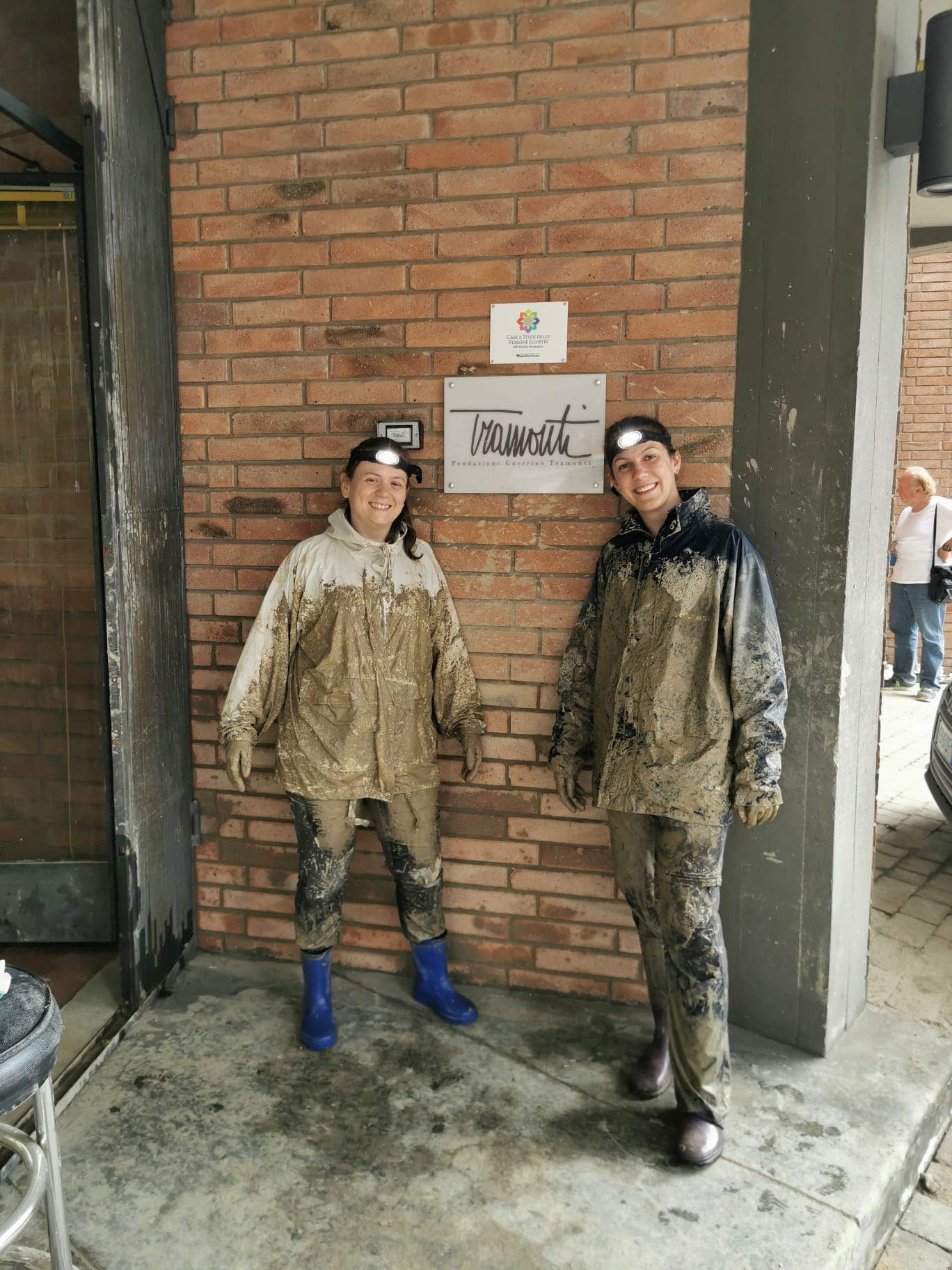 Guerrino Tramonti Museum
Guerrino Tramonti Museum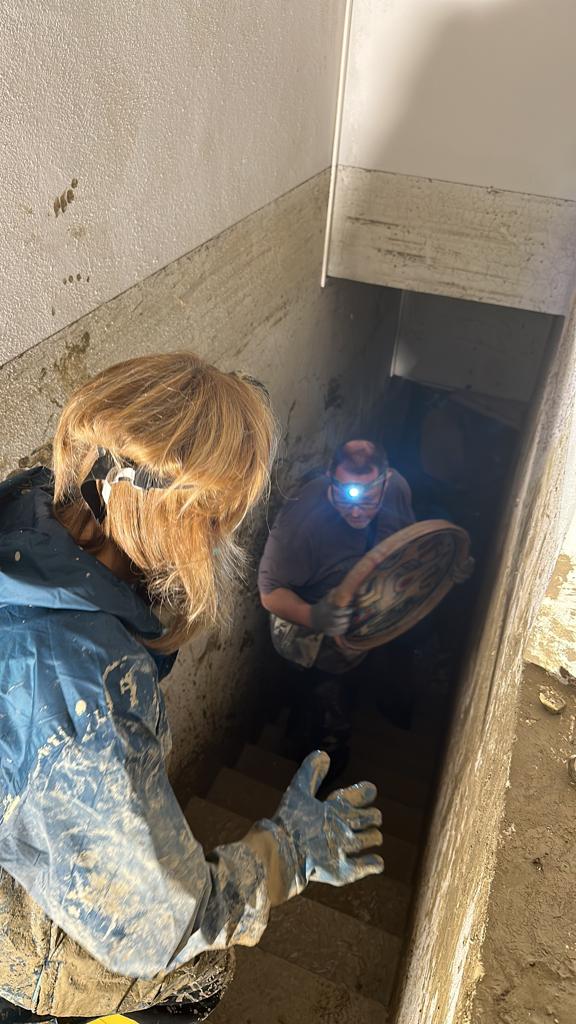 Guerrino Tramonti Museum
Guerrino Tramonti Museum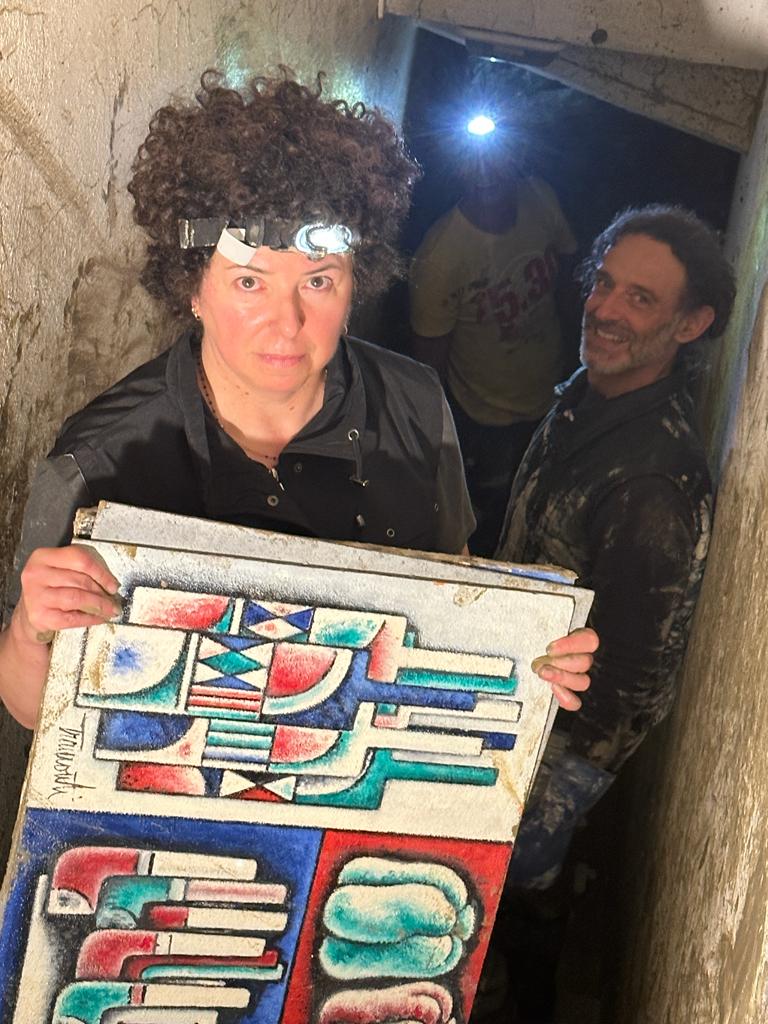 Guerrino Tramonti Museum
Guerrino Tramonti MuseumThe events of May 16 were surprising even though a few weeks earlier we had already experienced in Bagnacavallo the destructive force of water: the first flood, in addition to damage to homes and businesses, had in fact already filled the storage room of the Museo delle Cappuccine with mud, with damage fortunately limited to a few works and the floor to be cleaned. Although alerted in advance, the second wave with its spread and amplitude left us terrified and the first reaction once we realized that we were spared was to make sure that friends and relatives were safe, secondly verified that it was impossible to access our storage room because it was still surrounded by water and therefore unreachable, we tried to bring initial help to those in need.
So as the first groups of volunteers began to distribute around the city to provide relief in homes, we thought of the various museums in Faenza that might need some hands in an emergency that were used to handling works of art, and thoughts immediately ran to our friends at the Tramonti Museum. With Milena Camposano we participated in the past months in RE-ORG, an important training course promoted by the Cultural Heritage Sector of the Emilia-Romagna Region focused on the management of museum deposits, developed and proposed by ICCROM; a course as relevant as ever given that for 3 months we have been intensively working on hypotheses for the reorganization of museum deposits, to make them safe, usable and functional.
The impact with the flooded museum was definitely a shock, in fact we remembered clearly the images of the repository we had seen a few weeks earlier during the course, to be reorganized but all in all already quite functional and orderly; entering those now dark spaces, still submerged in water and mud was a hard blow. At that moment the structured aid machine that was set in motion in the following days had not yet started, and so in those first hours we found ourselves helping Milena and Marco in an initial organization of the work, trying to figure out what was most urgent and what was needed in order to work profitably to save as many works as possible. With our feet soaking in 40 cm of water and mud, we began scouring the storage room looking for the ceramics that had fallen and were now submerged, and the paintings that had been scattered throughout the rooms: some were completely covered in mud, others were submerged in water and needed to be taken out immediately to dry before the wooden support was completely lost.
While there was a very strong emotional component one of the things that struck me in those moments of great emergency was the lucidity of the hosts who with great decision and clarity of purpose were moving to find as much help and support as they could, even in the pain of seeing their assets put to such a hard test. In the days that followed we returned to help at other times, the work had become structured thanks to the presence of so many volunteers, more or less of the trade, who brought a truly amazing contribution of energy and enthusiasm that made it possible to secure all the works in a very short time. Obviously, in order to return to full functionality of the spaces and usability of the works, longer time will be needed but I am sure that Marco and Milena’s spirit and initiative will be the engine that will make these months full of fruitful dynamics, creating opportunities and new synergies.
When I arrived at the Guerrino Tramonti Museum, the only thing I knew was that the artworks had to be salvaged by moving them from storage, subject to flooding, to a safe area where they could be cleaned and stored, so what I expected was water and mud and soaked works. Unfortunately, quite different was the scene that presented itself to me once I accessed the storage rooms. The water, which had filled it up to the ceiling, the latter after three days after the flood event still dripping, with all the force with which it had entered it, had left the shelves of the various shelves orphaned of the works that occupied them, throwing them to the floor. The same fate had befallen the metal tables that most likely served as support and service to the Museum’s activities.
The feeling of helplessness in the face of the devastating force of Nature, in this specific case of water, makes you even more aware and understandable of the despondency of those who suffer such an event, the bewilderment that makes one unable to think clearly to the point of not knowing where and how to start in order to return to a semblance of normalcy. And this is what I picked up from the words of the museum directors. At that moment I understood how my being a pragmatic person, with nature and training as a technician, and having experience in managing archaeological repositories, turned a simple and modest help into something more, into something essential, a support, a resource to plan and proceed in the most appropriate way in recovering artworks. So free from emotions, which would have hindered and conditioned the decisions to be made, I was able to manage and begin the recovery operations, all together side by side, and over the course of the day bring to safety all the works of art taking care to separate those subject to future restoration from the unharmed ones waiting only to be cleaned from the mud that had enveloped them. Only when the work was done did I allow the emotions to emerge, so satisfied with the achievement of the goal, happy, truly happy to have been of help, the only reason that had brought me to the Tramonti Museum and aware that from the ashes, in the memory of what happened, Culture knows how to be reborn and restart, with a light heart, with one more experience, I got back in the car and drove home.
On the occasion of the May flood in Romagna, I think the feeling that united all of us was the desire to make ourselves useful, even if in our own small way, to those people who lost everything. I also think that these events, despite their brutality, tend to bring out the more human side of us that we too often tend to forget. For many years I have lived in this area, which has been like a second home, to attend my studies dedicated to the preservation of cultural heritage, and as a result it was spontaneous to turn my thoughts, not only to the people, but also to the cultural heritage that has suffered a severe blow. This is precisely why I happily accepted Simona Lombardi’s proposal to go and help the Tramonti Guerrino Museum in Faenza.
With Simona and a group of friends and volunteers, among whom I must mention Monica Mazzotta, from the very beginning we worked to make the Museum’s works as safe as possible. When we arrived at the Museum, most of the works had already been taken from the flooded basement, so the priority was to clean the paintings from the mud that had settled there to prevent it from drying out and then becoming more difficult to remove. It was a long job that kept us busy for a long time and is still not finished, but it left me with indelible memories and feelings. Beyond the practical work, the thing that struck me most was the sense of gratitude that Marco and Milena Tramonti showed through the countless thanks they gave us for doing what in my opinion needs no thanks whatsoever.
My name is Simona Lombardi, I am 25 years old and I was born in Pietrasanta in the province of Lucca. The affected lands are places dear to me as I have spent the last five years there attending the university of conservation and restoration of cultural heritage. As soon as I heard about the incident, I got in touch with friends who are in those areas and tried to keep up to date as best I could through social media as well. Thanks to the Finestre Sull’Arte page I was able to see some photos taken at the Guerrino Tramonti Museum that showed the rooms invaded by water and mud. Once I contacted Milena and Marco as soon as I could, I headed there with the desire and hope that I could help them out. I also decided to involve Gemma Giani, a friend and fellow student over the years, and other volunteers who were willing to come with us, thus going to the museum for the first time on Monday, May 22. In the previous days many volunteers had worked hard to retrieve the flooded works from the basement.
It was a blow to the heart to see the museum rooms overflowing with works piled on top of each other completely covered with mud to the point of being unrecognizable. Since these were mostly ceramics and paintings, we gave priority to the latter: it was indeed important to see to the removal of the mud before it dried out as it would then be much more complicated to clean up the pictorial surface. We rolled up our sleeves and got to work: from 9 a.m. until 6 p.m. four workstations were active so that we could clean several paintings at once and gradually start new ones. The method employed was based on the use of brushes and brushes softening the deposit to be removed with running water, paying special attention to paintings on canvas, which are more delicate than those made on another medium. Thus we continued for several days without interruption. thanks to the invaluable help of new volunteers.
The cleaned works were transported to the terrace, trying to dry them as much as possible by taking advantage of the available shaded areas and laying those that were beginning to board on the floor. They were then housed in an apartment set aside for this purpose, taking advantage of every available room and circulating the air as much as possible. At first it was hard to imagine the end of this massive work - in fact, it involved having to clean up more than a thousand paintings - but gradually the rooms emptied and the vivid colors returned to the light. It is inexplicable how excited I was to hear the words “this is the last one” spoken: we had finally made it.
At the same time, they went back to the basement several times to make sure that no work was left forgotten amidst the water and mud that was beginning to subside. As some volunteers worked to clean up the space by bringing out the things to be thrown away, more works emerged by recovering about fifty ceramics that miraculously remained intact, painting easels, plaster molds and a few other paintings. In addition to this, the entire area was sounded out by moving by areas and probing through the mud. In this way it was possible to fish out and rescue many ceramic fragments. Thanks to the willingness and alternation of volunteers, it was possible to carry out cleaning operations on many of the ceramics, starting with the intact ones. For this purpose, it was necessary to wipe the surface of the works several times with sponges soaked in water, thus removing the deposited mud. The ceramics were placed in one of the cleaned rooms of the museum, gradually making a breakdown between the whole works, the fragmented but complete ones, and the ceramic fragments on which work still needs to begin. To date it can be seen that much work has been done but that there is still a long way to go. As far as the paintings are concerned, it is necessary to continue to take care of their proper drying since on some of them the formation of mold was noticed so it was necessary to remove them by proceeding through the application of a biocide. It is essential to ventilate the rooms, reducing humidity and constantly monitoring the state of the works until they are completely dry. On the ceramic fragments and parts of plaster molds, still covered with mud, it will be necessary to intervene through cleaning and searching for connections between them in order to recompose as many works as possible. It was far-sighted to involve the university, particularly some of the lecturers of the restoration course and their willingness to carry out the lectures at the museum, suggesting improvements on the conservation of the works and ensuring continuity in the operations to be carried out.
I couldn’t believe what I saw on the news. I couldn’t believe what I heard on the radio. I couldn’t believe what the testimonies communicated to me. So I left to live and see what I didn’t want to know. How inspiring is it to breathe life back into what no longer has life? How satisfying is it to see fire reborn from ashes? What does it mean to regain the value and prestige that has been lost? This I asked myself... Mud, dirt, trash, dust, mud, mud, mud, mud, mud everywhere....
My small contribution to the Tramonti Guerrino Museum, together with friends and other volunteer girls, was for me a rediscovery, a stimulus to restart and be reborn together starting from art, from a museum space. I helped boys empty the basement in the dark and damp by rooting through the mud with my hands, slime up to my knees, cleaned several paintings with the water pump one by one, making the beauty of Tramonti’s paintings shine and revive, hidden by that corrosive sludge and soil. Behind the disaster experienced, a great unity, immense strength, immeasurable cheerfulness and so much positivity is what I felt and saw with my own eyes. Mud was being shoveled under the sun and the heat, piles of objects with no more value and shape, the more you moved the lower you sank and you could only wipe your eyes from the wet earth, but under this mud were the smiles of those who do not want to give up.
I will never forget the sight of the city as soon as I arrived: the heavy and motionless blanket of sticky mud, the tireless bulldozers, the smiles of those who do not give up and want to redeem themselves. I walked through the center with difficulty, because of the boots that regularly stuck in the muck, until I reached the Tramonti Museum. I was greeted by some volunteers working there and the fantastic owners, who with a smile summarily explained to me the work to be done. The works had to be cleaned as quickly as possible from the mud that had covered them, before it dried out and irreparably compromised the canvases. With brush and garden hose, I cleaned for hours as many paintings as I could, freeing from the patina of mud with brush after brush, the simple, harmonious forms, the intense colors, the beautiful faces and subjects of all features that under the slime were just waiting to come back to life. The most incredible emotion that I will forever carry with me was the chance to save the works of art in such a direct and unfiltered way, contributing, even if only minimally, to the preservation of so much beauty, despite the tragedy that surrounded us.
Rather than an account of how the volunteer experience went, we thought we would report a few thoughts that we shared in the days that followed. First of all, I (Martina), Simone and Francesco are off-site university students from Trento, Viterbo and Sulmona, respectively. We study Materials Chemistry in Faenza, a city that has been hosting us for two/three years now and for which, at such a complicated time, we decided to give our contribution. On the morning itself we met some scouts who directed us to the museum, we are actually not part of the parish or any other volunteer associations. For us, the overall experience had two sides: meanwhile, sadness to see the city under the mud, the stores, the houses, the devastated streets. It was as if the city showed another face, and the situation seemed impossible to accomplish. Then, happiness in making ourselves useful. We realized that the museum and the art you hold represent your life as well as your work. Despite the difficult conditions in which we were working, among the water, mud and heavy air, we were still one group moved by the common goal of returning to normalcy. It was an unexpected way to get to know the museum, its history and come in contact with Guerrino Tramonti’s art, but for us it was in any case a pleasure.
Only a few days before at the Tramonti House-Museum a special event had been held: the inauguration of a project carried out with great enthusiasm where the gallery rooms, full of works by the illustrious artist, had opened their doors to host some of the most celebrated masterpieces of the master Mario Bertozzi in a sort of first example of twinning between two important representatives of the Italian cultural world, both being part of the circuit “Homes and studios of the illustrious people of Emilia Romagna.” It was a great honor for me to be invited as a speaker to the opening day but also, a few days earlier, to have had the privilege of being able to stand in silent conversation with Tramonti’s creations in that purely personal atmosphere that is always created whenever I come into visual and emotional contact with masterpieces of art: that feeling of being in the presence of sacred entities since they are generated in mutual synergy by physical labor, intellect and heart, testimonies rich in value for the entire community in the presence of which I feel every time small and embarrassed even to utter any words of praise or even to breathe next to them.
Then the tragedy: it was my heart, by now so close to those works, that drove me, without any hesitation, to Casa Tramonti in an attempt to donate my small contribution and, right away, I found myself in the museum’s underground storerooms in contact with high water and with these jewels, now scarred, humiliated, destroyed, buried by a sacrilegious brown mush that concealed that venerable beauty that only a few days before was still intact. I joined a wonderful and warm human chain created in the basement of the building having the purpose of passing the works to each other to bring them up out of the mud and then hastily transport them to the upper floors, and while sharing this work, in the dark and equipped only with a miner’s flashlight, he came into my hands: a slime-stained painting representing a face, perhaps a self-portrait of Guerrino Tramonti himself! In the haste of the work our eyes met for a brief instant and that look spoke to me: in a split second I realized that the works that before I did not even dare to touch were at that moment there in my filthy hands, but that face soiled with earth and that painting violated by the muddy matter still continued to have a divine aura despite the humiliation it had received. I realized that the person in front of me already had another work ready to pass to me and so I surrendered the painting in my hands to the volunteer following me detaching myself from those eyes that will forever remain as the most important and teachable moment amidst the devastation that surrounded me allowing me to bring back to mind a thought by Pablo Picasso: “Art shakes from the soul the dust accumulated in everyday life.”
Laura: For months now we have started a collaboration between the Brindisi House Museum of Lido di Spina and the Guerrino Tramonti Museum for a program of initiatives planned for next year to enhance the two museums. After the flood, I felt I had to go. All in all, jumping in to help also serves to ease our own of spirit, that of neighbors grieving over what happened. Having verified with the Traffic Police that we could get there, Claudia, a teacher and archaeologist from Ferrara, and I therefore set off on May 21 to go and see what could be done. Compared to Comacchio, Romagna lies just south of the Valleys, and already at Alfonsine we encounter flooded fields, orchards, houses and churches. In Bagnacavallo we see the first boys intent on shoveling mud. However, all this does not prepare us enough for the arrival in Faenza. There are cars being rescued in the high areas, volunteer cars parked everywhere, people muddied, roads disrupted. As we approach the river area, we enter a kind of fog, created by dust from trucks and other vehicles carrying away mud and rubble. In front of the doors of houses are mountains of furniture, pieces of furniture and upholstery, the most disparate objects, all to be thrown away, all gray with mud and mostly unrecognizable. There is a smell of mud that permeates everything, mud and dust everywhere. There is an uncertain atmosphere between desolation and hope, the latter embodied especially by the many young people who are doing their best everywhere with shovels.
Claudia: Arriving in front of the house-museum Guerrino Tramonti, Marco Tramonti and Milena greeted us with smiles, despite the deep state of anguish that one cannot help but feel when you have seen the river, which used to flow quietly under the bridges of your town, enter the house. Some volunteers from Cesena’s San Domenico archaeological group, who had joined us in the meantime, escorted us inside, assigning each of us a task. After getting me a headlamp and a pair of gloves, they point me to the staircase leading to the underground archive, where works not displayed in the museum rooms were kept. They explain to me how they had organized themselves and all the precautions, to which it is necessary to adhere, and then, descending the steps that are lost in the dark water, I reach the floor. Walking with rubber boots in the slush up to half a leg, I bump into floating wooden boards and step on shards of I don’t know what, then, trying not to trip over the wreckage, I join the human chain intent on recovering the paintings. The smiles, light chatter and expert movement override the tension of urgency and dismay of finding ourselves in the dark with in our hands, immediately slippery from the slime, the paintings completely soaked and covered in mud. After emptying the lowest shelves, we reached out to grab the works that were on the top, heedless of the muddy shower raining down on us as we worried that they would not be injured. Having finished the operation, we finally climbed back up and immediately began to remove the mud from the works, an activity that continued over the next few days. Seeing the still intact forms reappear and the brilliance of the colors gave me a thrill I will not forget.
Laura: Arriving at the Tramonti Museum, we see that intense work is being done: many people are already bringing out the works from the basement storage. Claudia immediately disappears into the darkness of the storage room, with a flashlight on her forehead and her boots submerged in water almost up to her knee. I and three other volunteers, including Alessandro Porro, chain up the muddy stairs and distribute paintings and ceramics along the museum’s halls. I am especially struck by the paintings, soaked and covered in mud. They are on canvas and masonite, a few on multilayer boards, on chipboard of some sort, or on cardboard. I dejectedly wonder how they will be saved and am told by Laura, my namesake, “meanwhile bring them up and don’t think about it!” Right. The family knows that Guerrino Tramonti used to wash their paintings with tap water, so strong is their subject matter. They try. They are oil paintings of a compact surface, incorporating sand to give materiality to the surface. The mud is a fine, hazelnut-colored, highly diluted clay (just like a slip), which comes off well under the jet of water from the garden hose, with the help of a light sweep of a soft brush over the surface.
In the emergency, a quick decision must be made and action must be taken before the mud dries and leaves no choice. The owners take the responsibility to wash the mud away with water. I think it is the right decision because I see that the surface of the works is compacted. It is not a matter of taking it upon themselves to wet the works, as they are already soaked with water. The supports also seem to be holding up well. I think clean water can also take away some of the pollutants that the flood has carried. Above all, if mud were left on the works, I fear it would cling very much to the rough surface of the paintings and, as it dries and recedes, could cause cracking and peeling. And in any case it would be removed with great difficulty.
On ceramics, one acts only with a sponge, slowly carrying the mud away. Glazed ceramics do not seem to have a problem. The heavy, thick glazed ones look a bit tarnished, probably having absorbed dirty flood water from the typical surface cracks, I can’t tell. They are very delicate. We are comforted by the presence of two restorers who came from Florence and are coordinating the work. In the House Museum there is an empty apartment on the second floor, which fills up with the washed works as the days go by, after they have disposed of some moisture on the ground floor or on the terrace, in the shade. The garden where they work with water is an expanse of quicksand, while in the museum they try to keep the floor washed and not too wet, despite all the muddy boots that ply it back and forth.
Eventually in the second floor apartment and the museum’s great hall there are more than 1,300 paintings and many ceramics. A colorful mosaic. Some paintings seem not to have been affected at all by the misadventure, on others there remains a light patina of clay that I think can be removed with appropriate wraps in a professional restoration. Regarding the supports, the canvases show no visible problems. Some of the works on masonite and plywood tend to warp as they dry. They are left horizontal as much as possible. There are also works, especially on cardboard and chipboard, in which there are areas of lifting and flaking of the back, but in which the paint surface resists. Others-a small percentage, fortunately-have detachments of parts of the painting or support: these are left as they are, without trying to intervene.
Lastly, plaster molds and fragments of broken ceramics, formerly or during the flood, and some semi-processed ceramics left unfinished by Tramonti are extracted from the underground storage. The presence of mud on these objects is even more important. As evidence of Guerrino Tramonti’s extreme craftsmanship, the plasters are strong and compact, with clean surfaces, with very few exceptions where marginal parts seem to flake off and show the presence of the fibers embedded in the plaster. But these are very few, perhaps already ruined from before. There are molds for three-dimensional sculptures and for bas-reliefs. Few molds for bas-reliefs are rinsed of the still-liquid mud. Mostly mud is left on both plaster molds and ceramic fragments, especially thick-glazed plates, also in anticipation of a research intervention by students and professors from the University of Bologna planned for the following days.
The damage is extensive. Part of the archive has been lost. Some of the walls up to the level where the water came in, are cracked, have mold or are even destroyed, some doors no longer close, and the floor has blown up in several places. Plants in the garden are buried by clay. In the same way as many other gardens where maybe a rose is sprouting, the top of some dying plant from a desert of mud that is drying and cracking. It will take time and effort, but the museum will flourish again.
Much of what humanity has had to invent over the course of its tenure on the planet arises in relation to, when not in response to, unforeseen events that change a paradigm. That break a continuity. This is nothing new; the mistake should not be made of thinking that what happens to us is always and everywhere something new and unique.
May’s landslides have changed-presumably not for the first nor last time-the paradigm of relationship with our hilly terrain. Certainly change is traumatic by definition. It opens wounds, but also possibilities.
A wide range of evaluations of what has recently happened in Romagna is up to field technicians, politicians, and institutional representatives. There is no question that we need to reflect on climate change, and before that on taking care of the land, and do so as far from hashtags and slogans as possible.
I have no doubt that there are new instances to be taken up, even starting from these events. I have a natural - I hope healthy - resistance to unified-network dogmas. Generally those advocate changing a commercial paradigm, not a cultural one.
It is incumbent on artists, I believe, to have a non-quantitative analysis of events. I believe it is primarily incumbent upon them to work on the soul and sense of communities, traumatized and marginalized by a new sense of powerlessness and isolation. By an ancient but also new fear, which also has to do with the very modern concept of FOMO (Fear Of Missing Out), of fear of being cut off, not only from the news cycle, not only from communication networks, but from the flow of things moving and evolving. The periphery returning to the periphery, which cannot keep up with the center. Which depopulates and disappears.
In the face of traumatic events, I do not believe in the logic of lyres hanging from willow branches, respectful silence, and even less do I believe in an art that under the guise of documenting produces a selfie of itself, with disaster in the background. I believe in an art that stands for itself as an integral part of everyday life and knows how to put stimuli, energies, cues back into circulation. Vital.
We asked artist friends, mostly musicians, to work on the concept of community. And of hospitality. Even before raising funds, the point is to share, to invite people to come up to Modigliana again, not to be afraid, to con-live the historic center, right next to one of the rivers that was about to overflow, right under the landslides that changed the landscape overnight.
So many people responded, we made a little festival out of it called Terra Mossa. Music, but also openstudios and book presentations. Terra Mossa, like that came down from the mountains, on the roads, like our Earth that must remain in motion, vital, evolutionary, and not be crushed.
The hill, the periphery, that creates community and events in its own way, with its own systems and specificities, and does not chase downward the trends of the center. Which starts with its artists, pools and produces ideas. Which rethinks itself as a vital territory of experimentation. Which gives its own, collective response, and gives it on the street, to the deafening social-individualist chatter.
No more than three years ago we made the inexcusable mistake of thinking that an emergency, albeit’ serious, could presuppose the suspension of any other social, spiritual, ethical need of a community, and upstream even of a civil debate. It was an immeasurable social disaster whose effects have already and for years will cross those of the emergency itself.
Terra Mossa means that first and foremost one cannot and should not stand still, in the face of anything. It can be a one-off, or even a first edition of something new.
For now, that is the first answer that came to our minds. Stop by and see us.
Warning: the translation into English of the original Italian article was created using automatic tools. We undertake to review all articles, but we do not guarantee the total absence of inaccuracies in the translation due to the program. You can find the original by clicking on the ITA button. If you find any mistake,please contact us.